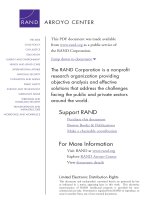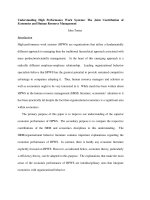Human resource management disease ch 13
Bạn đang xem bản rút gọn của tài liệu. Xem và tải ngay bản đầy đủ của tài liệu tại đây (46.94 KB, 12 trang )
Chapter 13
Diseases of the Nervous System and
the Special Senses
Organs and Function
Brain – Three major areas: Cerebrum,
cerebellum, brain stem – all covered by
meninges. CSF formed in ventricles of
cerebrum as well as nerve cell bodies, the
cerebellum controls voluntary movement, the
brain stem is the ‘vitals’ center because it
regulates heart and lungs.
Spinal cord – within vertebral column,
contains tracts of nerve fibers to ascend to
and descend from brain carrying messages to
and from muscles, organs, and glands
Elsevier items and derived items © 2009 by Saunders, an imprint of Elsevier Inc.
2
Organs and Function
Autonomic Nervous system – houses
sympathetic and parasympathetic nervous
systems. Controls homeostasis, i.e. blood
pressure, heart rate, gastrointestinal function,
sweating, temperature and other involuntary
actions
Sensory Nervous system – Sensations
detected from eyes, ears, skin, muscles,
tendons, internal organs and transmitted to
central nervous system (spinal cord, brain)
Elsevier items and derived items © 2009 by Saunders, an imprint of Elsevier Inc.
3
Organs and Function
Motor Nervous system – controls discrete
movements of skeletal muscles, helps
muscles work together, speech, motor skills
Elsevier items and derived items © 2009 by Saunders, an imprint of Elsevier Inc.
4
Diagnostic Tests
EMG – Electromyelography – Radiographic
process viewing spinal cord and spinal
subarachnoid space to identify spinal lesions
caused by trauma or disease.
EEG – Electroencephalography - Records
electrical activity of the brain to diagnose lesions
or tumors, and seizures, in impaired
consciousness.
MRI – Magnetic Resonance Imaging – To view
and record tissue characteristics at different
planes. To visualize brain soft tissue, spinal cord,
tumors, hemorrhages
Elsevier items and derived items © 2009 by Saunders, an imprint of Elsevier Inc.
5
Diseases of the Nervous System
Signs and symptoms
Meningitis – High fever, chills, severe
headache, stiff neck, nausea, vomiting, rash,
delirium, convulsions, coma
Encephalitis – Mild-severe headache, fever,
cerebral dysfunction, disordered thought,
seizures, persistent drowsiness, delirium, coma
Poliomyelitis – Stiff neck, fever, headache,
sore throat, GI disturbances, possible paralysis
Elsevier items and derived items © 2009 by Saunders, an imprint of Elsevier Inc.
6
Diseases of the Nervous System
Signs and symptoms
Tetanus – Rigidity of muscles, painful spasms and
convulsions, stiff neck, difficulty swallowing,
clenched jaws
Shingles – Painful rash (sm water blisters w/red rim)
lesions along sensory nerve on one side of body,
severe itching, scarring
Abscess – Fever, headache
MS – Multiple Sclerosis – Muscle impairment,
double vision, loss of balance, tingling, numbing,
tremors, weakness, emotional changes, remission,
exacerbation
Elsevier items and derived items © 2009 by Saunders, an imprint of Elsevier Inc.
7
Diseases of the Nervous System
Signs and symptoms
ALS – Amyotrophic lateral sclerosis –
disturbed motility, muscle atrophy in hands,
forearms, and legs, impaired speech and
swallowing, death from pulmonary failure (3-4
years)
Convulsion epilepsy – Involuntary
contractions, seizure shows illness – not
disease. Petit mal: brief loss of
consciousness. Grand mal: aura , total loss of
consciousness, convulsions, hypersalivation
Elsevier items and derived items © 2009 by Saunders, an imprint of Elsevier Inc.
8
Diseases of the Nervous System
Signs and symptoms
Spina bifida – Opening in vertebral canal,
meningocele, nerve tissue disorganized
Hydrocephalus - Enlarged head develops
Cerebral Palsy – Seizures, visual or auditory
impairment, speech defects. Spastic: tense
muscles, reflexes exaggerated. Athetoid:
Uncontrollable, persistent movements,
tremor. Atactic: Poor balance, poor muscular
coordination, staggering gait
Elsevier items and derived items © 2009 by Saunders, an imprint of Elsevier Inc.
9
Diseases of the Nervous System
Signs and symptoms
TIA – Mini strokes – Visual disturbances,
muscle weakness on one side, sensory loss
on one side, slurred speech, lasts minutes to
hours, avg is 15 min
CVA – Stroke – Severe, sudden headache,
muscular weakness or paralysis, speech
disturbance, loss of consciousness
Alzheimer’s Disease – Memory loss, moody,
indignent
Elsevier items and derived items © 2009 by Saunders, an imprint of Elsevier Inc.
10
Diseases of the Nervous System
Signs and symptoms
Conjunctivitis – Inflamed eye surface,
oozing
Glaucoma – Elevated intraocular pressure,
dim vision
Cataracts – Blurred, dim vision
Macular degeneration – Central vision loss
Diabetic retinopathy – Blurred, cloudy vision
to blinded
Elsevier items and derived items © 2009 by Saunders, an imprint of Elsevier Inc.
11
Diseases of the Nervous System
Signs and symptoms
Otitis media – Internal fluid pressure, fever
Tinnitus – Ringing, roaring internal sounds
without real external sounds
External Otitis – Discharge, pus
Elsevier items and derived items © 2009 by Saunders, an imprint of Elsevier Inc.
12









